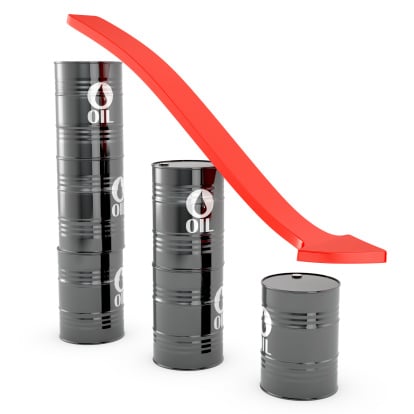
Source: thinkstock
We wanted to take a look at what could happen if WTI crude falls below $90 a barrel and stays there for a while. WTI bounced off a price below that level already in September, but it has not spent any time below $90 a barrel since January.
First, let’s look at some expectations. Estimates of demand growth from OPEC, the U.S. Energy Information Administration (EIA) and the International Energy Agency (IEA) place demand growth at 900,000 to 1.05 million barrels a day in 2014, and rising to around 1.2 million to 1.3 million barrels a day in 2015.
Supply growth is projected to rise by around 1.6 million barrels a day in 2014 and 1.3 million barrels a day in 2015. Almost all of that growth will come from onshore U.S. production, particularly in North Dakota’s Bakken and the Permian Basin and Eagle Ford plays in Texas.
Supply is growing faster than demand, and the next question is how much of the lost demand is permanent and how much is temporary. Improved mileage performance in new cars will only continue to destroy U.S. demand permanently. Countering that decline is increased demand from developing nations, particularly China and India, for more oil to fuel more cars. That is where the demand growth is coming from.
ALSO READ: Oil Demand Falls According to IEA
The problem for the major integrated oil companies is that lower prices make it difficult to fund both capital investment and investor returns. Having watched what happened in the past couple of years to top managers in the mining industry who accumulated more assets at the expense of increasing investors’ returns, the captains of the oil industry are reining in capital spending and maintaining their returns to shareholders.
If oil prices fall below $90 a barrel for an extended period, capital spending at Exxon Mobil Corp. (NYSE: XOM), Chevron Corp. (NYSE: CVX), BP PLC (NYSE: BP), Royal Dutch Shell PLC (NYSE: RDS-A) and ConocoPhillips (NYSE: COP) will almost certainly have to be reduced to maintain payments to shareholders.
That is a slippery slope that could eventually lead to a shortfall in supply driving prices up just as quickly as — or more quickly than — they fell. The benefit to consumers could evaporate virtually overnight.
U.S. pump prices are expected to fall below $3 a gallon in many U.S. states and cities by the end of 2014. Consumers will finally get some relief from prices that rose above $4 a gallon in many cities earlier this year.
And it’s not just gasoline pump prices. Airline fuel consumption has dropped almost 15% since its peak in 2005, partly due to cutting down on the number of flights, but also due to flying at slower speeds and reducing weight in order to consume less fuel. Between 2004 and 2011, the average ground speed of seven major U.S. air carriers decreased by 1.1%. Planes have cut weight by eliminating magazines, heating ovens and even safety equipment for water landings if the planes don’t fly over water.
ALSO READ: 3 Favorable High-Yield MLPs to Buy
Domestic jet fuel prices have fallen from around $2.90 a gallon to around $2.70 a gallon since June. Jet fuel prices may pick up slightly going forward, but that will be due largely to airlines hedging at current prices. Of course consumers aren’t likely to see any reductions on ticket prices, but airline stocks should continue to prosper
The other places to look for evidence that crude prices will continue falling in the near term are the futures markets for both WTI and Brent. The most recent Commitment of Traders report from the ICE shows the lowest number of long positions since June 2012. A similar report from the NYMEX showed net long positions down 4.8% in the week ending September 23.
Some traders are looking at this as an opportunity to buy into long positions again, but the forces arrayed against a rise in crude prices now outweigh the forces that believe prices will rise soon.
The short version of the story is that if crude oil prices fall below $90 and stay there for a while, look for oil companies to do all they can to raise prices again. Besides cutting production and storing the oil in the ground, there are likely to be plenty of calls for allowing U.S. oil exports again. We haven’t heard much about that recently because no member of Congress wants to be allied with exporting oil before the November elections on the off chance that crude prices might rise and export supporters might end up getting blamed for the higher oil prices. Once the votes are counted, though, the chorus will be getting tuned up.
ALSO READ: 5 Permian Basin Oil Stocks to Buy After Huge Oil Sell-Off
Sponsored: Find a Qualified Financial Advisor
Finding a qualified financial advisor doesn’t have to be hard. SmartAsset’s free tool matches you with up to 3 fiduciary financial advisors in your area in 5 minutes. Each advisor has been vetted by SmartAsset and is held to a fiduciary standard to act in your best interests. If you’re ready to be matched with local advisors that can help you achieve your financial goals, get started now.
Thank you for reading! Have some feedback for us?
Contact the 24/7 Wall St. editorial team.


